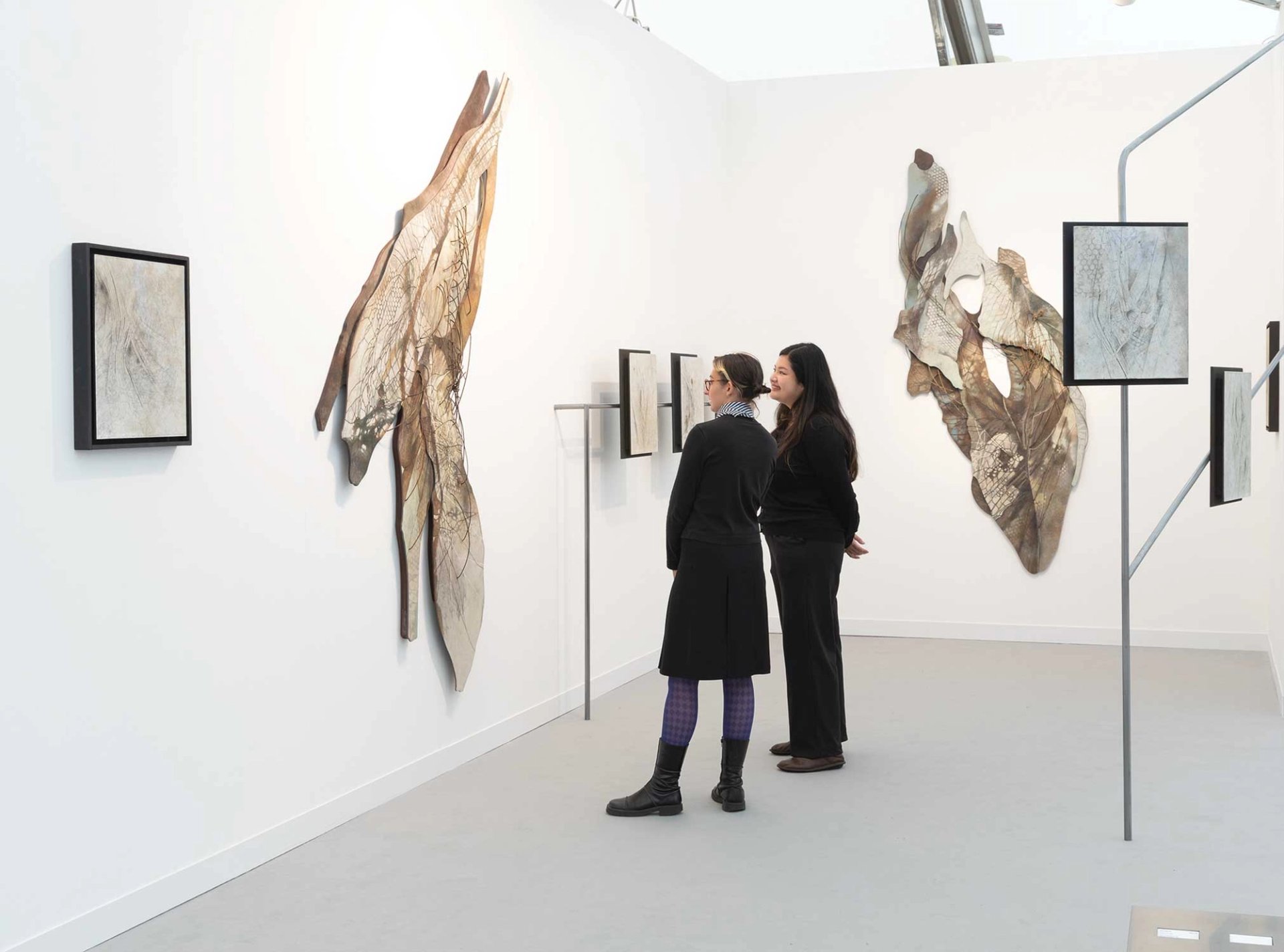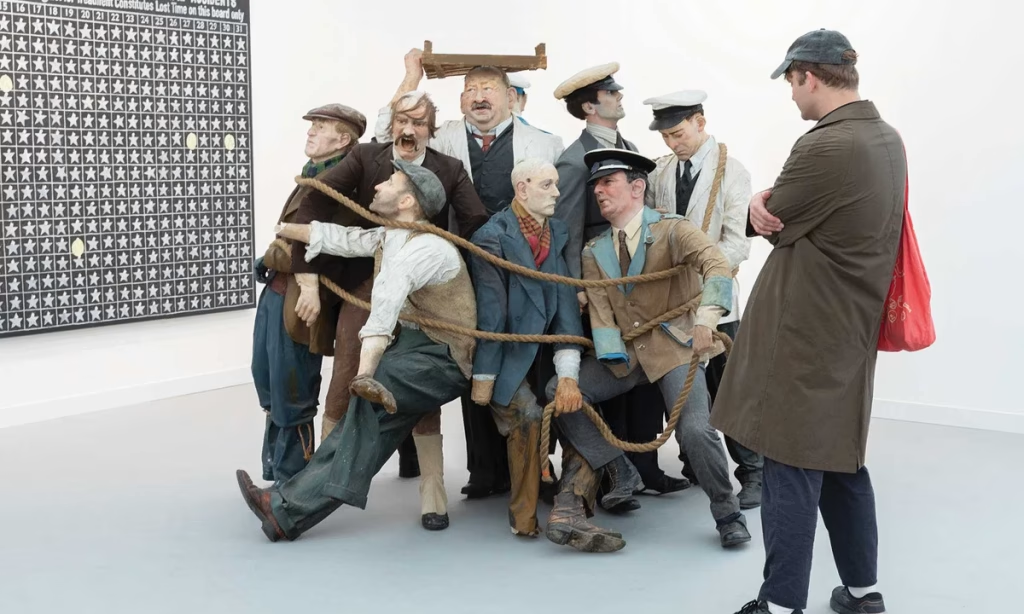In a fair awash with painting, Focus—the section dedicated to galleries up to 12 years old—is an invigorating burst of variety and imagination. The six stands featured here include works made in materials from glass and tar to pastel, etching, found mannequins, calico and plastic, in which painting occasionally insinuates itself. The subject matter, too, is diverse, but if there is an insistent theme it is—not unexpectedly for predominantly younger artists—one of climate breakdown. Here are the standout booths of the Focus section.
Alex Margo Arden, By All Accounts
Ginny on Frederick, London
A two-part installation focusing on histories of labour, at its heart is a cluster of mannequins—once in use at the National Motor Museum, Beaulieu in Hampshire—bound together with rope. Formerly employed in dioramas to illustrate industrial history, these working people are now severed from their original purpose—one of numerous metaphors in Arden’s work. And they are quite literally severed: many have limbs or even a head missing. The work on the wall behind them is a painting of a Daily Departmental Accident Record from a Hollywood film studio, a table in which injuries to different departments of a film production are catalogued with gold discs representing time lost to injury. The linking thread is the idea that sometimes bloodied labour lies behind spectacle.
Luís Lázaro Matos, Benny Blown Away
Madragoa, Lisbon
Luís Lázaro Matos transforms a real story, of a beluga whale stranded in the River Thames in 2018, into a contemporary myth. He transports “Benny” to warmer climes, a sort of queer paradise of anthropomorphised Cetacean revellers, living and loving amid azure oceans, verdant headlands and Modernist villas. Realised in pastel and pinned with glistening shell-like forms to walls covered in murals of oceanic spume and spray, Matos’s drawings nod to the curvaceous sensuality of Jean Cocteau’s murals and to the fluid overlapping forms of Francis Picabia, among others.

Rim Park, Trackers
Cylinder, Seoul
Through relief sculptures and etchings with oil and ink, Rim Park explores plant anatomy. Multiple plant specimens are fused to create hybridised organic forms. The etchings feature drawings from microscopic specimens overlaid from several plates, with an exquisite variety of marks, from clusters of tiny dots to flurries of cross-hatching. They evoke both the surprisingly sculptural world beneath the microscope but also the patterns and anomalies held in the surfaces of flora. Reliefs made with pigment and oil on birchwood, with multiple leaf-like shapes tied together with wire, begin to resemble insect wings. Park uses scientific apparatus not to seek empirical truth but to speculate on a post-human world—how, as she puts it, plants will survive us.
Lara Fluxà
Bombon, Barcelona
Six cables stretch across this booth, with forms resembling the glass and ceramic insulators found on electricity pylons. They contain various substances including tar and alcohol. A certain precarity is suggested by these fragile, liquid-filled forms hovering over our heads, especially because they have developed organic protuberances—growths that reflect Lara Fluxà’s interest in environmental catastrophe. But alongside the hazards of the Barcelona-based artist’s sculptures are material and aesthetic delights, in the delicacy of the crafting of the glass forms, and in the beauty of the shadows they cast, like spectral drawings on the booth’s white walls.
Delaine Le Bas
Yamamoto Keiko Rochaix, London
Delaine Le Bas has composed a booth swathed in calico fabric sewn together with red thread and ribbon, a material laden with symbolism in different cultures, including Ancient Greek and Roman mythology. Protest is in the air: a placard reads “know state control” (in a variation, a tiny photographic portrait on the wall features Le Bas holding a sign saying “No state control”), while on a hanging textile, a painted image of Snow White, with drips falling from the red painted bow on her head, is accompanied by the words “Snow White is not so clean. Blood on her hands”. Le Bas’s precise meaning is ambiguous, but beneath the Disney figure are the words “waste”, “colonialism” and “toxic”. Folk and fairy tales and stories of witchcraft, with their persistent cruelties, are a potent tool for Le Bas to reflect on ongoing and contemporary injustices.
Enrique López Llamas, The Other Protagonist of the Night
Llano, Mexico City
The core of López Llamas’s booth is a video on the wall, in which coming-of-age stories evoke imagery from music videos (Michael Jackson) and art (Charles Ray’s Plank Piece performance photographs). Dotted around are sculptures cast in plastic and then hand-painted. Polyphonic cultural references abound: Count von Count from Sesame Street is translated into a Day of the Dead character, Dürer’s Praying Hands appear amid a spider’s web, the Venus of Willendorf sits amid a bag of old socks, while a Mickey Mouse hand emerges from a naked bottom on the wall. It is a tableau of hallucinatory images: where do we come from and what do we add up to?
